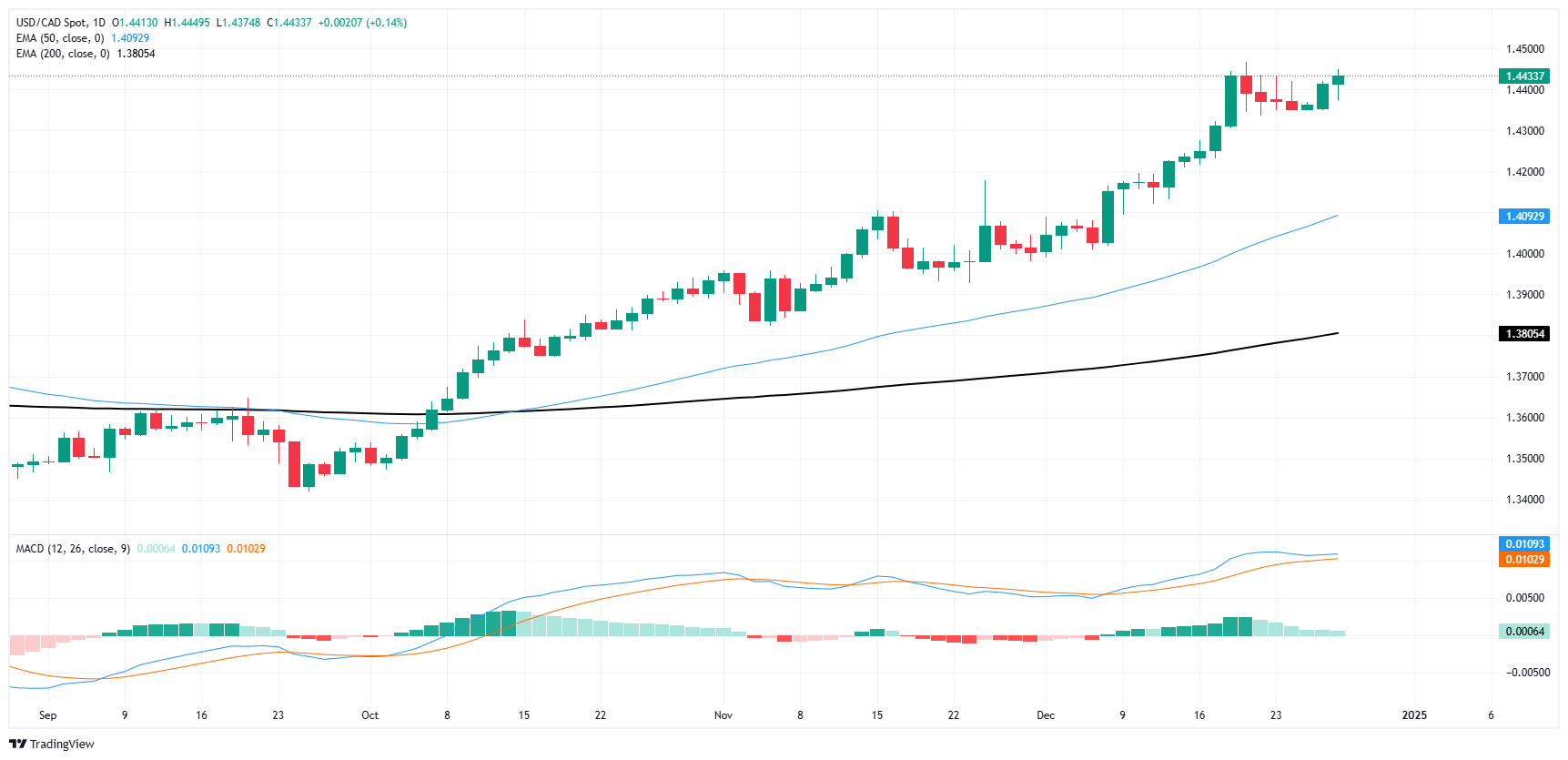- The Canadian Dollar retested recent lows and struggled to find gains.
- Canada’s economic data agenda remains incredibly thin in the near term.
- The divergence of monetary policy rates will be the main driver of the CAD for 2025.
The Canadian Dollar (CAD) continued its weak stance on Friday, falling to familiar short-term lows and losing a quarter of a percentage point against the US Dollar. The CAD is entering a lull with no releases on the data agenda for the foreseeable future, leaving CAD traders struggling near multi-year lows.
Following the mid-week market closure for the Christmas holiday, a weak market footprint remains ahead of the mid-week New Year’s holiday next Wednesday.
Daily Market Summary: CAD Holds Near Multi-Year Lows
- The Canadian Dollar continues to move near 56-month lows, pushing the USD/CAD rate above the 1.4400 level.
- Limited holiday markets will slowly extend into the new year, but volumes will remain low for the time being.
- Canada’s economic data is completely absent from the release schedule next week.
- The upcoming mid-week market closure for New Year will further hamper market flows.
- The Bank of Canada (BoC) is expected to continue cutting rates, while the Federal Reserve (Fed) is set to slow the pace of cuts in 2025, widening the policy rate divergence that is currently hitting the CAD.
Canadian Dollar Price Forecast
The Canadian Dollar turns lower to close out the Christmas trading week, falling against the Dollar and pushing USD/CAD towards the upper end of recent congestion on the chart. The pair continues to rise as bids trade well above the 50-day EMA near 1.4100.
December is set to close in the green and will see a fourth consecutive month of gains for USD/CAD as CAD plummets. Both Dollar buyers and CAD sellers will target a long-term barrier near 1.4700, where the pair would be pushing its highest bids in over 20 years. For now, the uptrend must surpass the December peak of 1.4467.
USD/CAD daily chart
Canadian Dollar FAQs
The key factors that determine the price of the Canadian dollar (CAD) are the level of interest rates set by the Bank of Canada (BoC), the price of oil, Canada’s main export product, the health of its economy, inflation and the trade balance, which is the difference between the value of Canadian exports and its imports. Other factors are market confidence, that is, whether investors bet on riskier assets (risk-on) or look for safe assets (risk-off), with the risk-on being positive for the CAD. As its largest trading partner, the health of the US economy is also a key factor influencing the Canadian dollar.
The Bank of Canada (BoC) exerts significant influence over the Canadian Dollar by setting the level of interest rates that banks can lend to each other. This influences the level of interest rates for everyone. The BoC’s main objective is to keep inflation between 1% and 3% by adjusting interest rates up or down. Relatively high interest rates are usually positive for the CAD. The Bank of Canada can also use quantitative easing and tightening to influence credit conditions, with the former being negative for the CAD and the latter being positive for the CAD.
The price of oil is a key factor influencing the value of the Canadian Dollar. Oil is Canada’s largest export, so the price of oil tends to have an immediate impact on the value of the CAD. Generally, if the price of oil rises, the CAD also rises, as aggregate demand for the currency increases. The opposite occurs if the price of oil falls. Higher oil prices also tend to lead to a higher probability of a positive trade balance, which also supports the CAD.
Although inflation has traditionally always been considered a negative factor for a currency, as it reduces the value of money, the opposite has actually happened in modern times, with the relaxation of cross-border capital controls. Higher inflation often leads central banks to raise interest rates, attracting more capital inflows from global investors looking for a lucrative place to store their money. This increases the demand for the local currency, which in the case of Canada is the Canadian Dollar.
The published macroeconomic data measures the health of the economy and may have an impact on the Canadian dollar. Indicators such as GDP, manufacturing and services PMIs, employment and consumer confidence surveys can influence the direction of the CAD. A strong economy is good for the Canadian dollar. Not only does it attract more foreign investment, but it may encourage the Bank of Canada to raise interest rates, resulting in a stronger currency. However, if economic data is weak, the CAD is likely to fall.
Source: Fx Street
I am Joshua Winder, a senior-level journalist and editor at World Stock Market. I specialize in covering news related to the stock market and economic trends. With more than 8 years of experience in this field, I have become an expert in financial reporting.







